Innovative Approach for the Evaluation of the Mechanical Behavior of Dissimilar Welded Joints
Abstract
1. Introduction
2. Materials and Methods
- as a first step, surface residual stresses are measured, both in the longitudinal direction and transverse to the weld seams, through a more precise and possibly nondestructive technique, such as X-ray diffraction;
- next, measurements are extended to depth by exploiting the contour method, which determines a 2D map of residual stresses acting normal to a plane [44]. This technique is easily applicable and particularly suitable to welded joints, owing to the fact that it is not affected by microstructural changes and inhomogeneities, and it is capable of capturing even steep stress gradients [44,45]. Indeed, it has been successfully employed on dissimilar joints, especially friction-welded [42,46,47,48,49];
- since the contour method is a destructive technique and capable of measuring only one stress component per each cut, longitudinal stresses, which are generally larger in magnitude, should be measured as first followed by transverse stress;
- subsequently, fatigue tests have to be performed in conjunction with a thermographic analysis of the increase in surface temperature of the specimens to monitor the failure zone [43];
- finally, fractographic and chemical assessment of the fracture surfaces has to be carried out;
- a final integration of all the information will allow for a thorough evaluation of the fatigue behavior of the joint and of the mechanisms and the nature of the observed fracture.
2.1. Materials and Welding Conditions
2.2. Residual Stresses
2.3. Fatigue Testing
2.4. Failure Analysis
3. Results
3.1. Residual Stresses
3.2. Fatigue
3.3. Failure Analysis
4. Conclusions
Author Contributions
Funding
Institutional Review Board Statement
Informed Consent Statement
Data Availability Statement
Conflicts of Interest
References
- Fang, Y.; Jiang, X.; Mo, D.; Zhu, D.; Luo, Z. A review on dissimilar metals’ welding methods and mechanisms with interlayer. Int. J. Adv. Manuf. Technol. 2019, 102, 2845–2863. [Google Scholar] [CrossRef]
- Wu, T.; Ma, Y.; Xia, H.; Geng, P.; Niendorf, T.; Ma, N. Measurement and simulation of residual stresses in laser welded CFRP/steel lap joints. Compos. Struct. 2022, 292, 115687. [Google Scholar] [CrossRef]
- Farabi, N.; Chen, D.L.; Zhou, Y. Microstructure and mechanical properties of laser welded dissimilar DP600/DP980 dual-phase steel joints. J. Alloys Compd. 2011, 509, 982–989. [Google Scholar] [CrossRef]
- Vaidya, W.V.; Horstmann, M.; Ventzke, V.; Petrovski, B.; Koçak, M.; Kocik, R.; Tempus, G. Improving interfacial properties of a laser beam welded Dissimilar joint of aluminium AA6056 and titanium Ti6Al4V for aeronautical applications. J. Mater. Sci. 2010, 45, 6242–6254. [Google Scholar] [CrossRef]
- Chen, H.C.; Pinkerton, A.J.; Li, L. Fibre laser welding of dissimilar alloys of Ti-6Al-4V and Inconel 718 for aerospace applications. Int. J. Adv. Manuf. Technol. 2011, 52, 977–987. [Google Scholar] [CrossRef]
- Zhou, Z.; Gao, X.; Zhang, Y. Research Progress on Characterization and Regulation of Forming Quality in Laser Joining of Metal and Polymer, and Development Trends of Lightweight Automotive Applications. Metals 2022, 12, 1666. [Google Scholar] [CrossRef]
- Handa, V.; Goyal, P.; Sehgal, S. Low Cost Joining of Inconel 625 and Super Duplex Stainless Steel 2507 through Novel Technique. J. Mater. Eng. Perform. 2022, 1–6. [Google Scholar] [CrossRef]
- Handa, V.; Goyal, P.; Goyal, S. Application of graphite rods in producing Inconel 625 (UNS N06625) joints through the use of microwave radiation energy. Indian J. Eng. Mater. Sci. 2022, 29, 378–384. [Google Scholar] [CrossRef]
- Hao, X.; Dong, H.; Xia, Y.; Li, P. Microstructure and mechanical properties of laser welded TC4 titanium alloy/304 stainless steel joint with (CoCrFeNi)100-xCux high-entropy alloy interlayer. J. Alloys Compd. 2019, 803, 649–657. [Google Scholar] [CrossRef]
- Liu, H.; Aoki, Y.; Aoki, Y.; Ushioda, K.; Fujii, H. Principle for obtaining high joint quality in dissimilar friction welding of Ti-6Al-4V alloy and SUS316L stainless steel. J. Mater. Sci. Technol. 2020, 46, 211–224. [Google Scholar] [CrossRef]
- Liu, G.; Gao, X.; Peng, C.; Huang, Y.; Fang, H.; Zhang, Y.; You, D.; Nanfeng, Z. Optimization of laser welding of DP780 to Al5052 joints for weld width and lap-shear force using response surface methodology. Opt. Laser Technol. 2020, 126, 106072. [Google Scholar] [CrossRef]
- Quazi, M.M.; Ishak, M.; Fazal, M.A.; Arslan, A.; Rubaiee, S.; Qaban, A.; Aiman, M.H.; Sultan, T.; Ali, M.M.; Manladan, S.M. Current research and development status of dissimilar materials laser welding of titanium and its alloys. Opt. Laser Technol. 2020, 126, 106090. [Google Scholar] [CrossRef]
- Corigliano, P.; Crupi, V. Review of fatigue assessment approaches for welded marine joints and structures. Metals 2022, 12, 1010. [Google Scholar] [CrossRef]
- Zhu, Z.; Lee, K.Y.; Wang, X. Ultrasonic welding of dissimilar metals, AA6061 and Ti6Al4V. Int. J. Adv. Manuf. Technol. 2012, 59, 569–574. [Google Scholar] [CrossRef]
- Seretsky, J.; Ryba, E.R. Laser Welding of Dissimilar Metals: Titanium to Nickel. Weld. J. 1976, 55, 121–208. [Google Scholar]
- Chatterjee, S.; Abinandanan, T.A.; Chattopadhyay, K. Microstructure development during dissimilar welding: Case of laser welding of Ti with Ni involving intermetallic phase formation. J. Mater. Sci. 2006, 41, 643–652. [Google Scholar] [CrossRef]
- Chatterjee, S.; Abinandanan, T.A.; Chattopadhyay, K. Phase formation in Ti/Ni dissimilar welds. Mater. Sci. Eng. A 2008, 490, 7–15. [Google Scholar] [CrossRef]
- Zhang, Y.; Gao, X.; You, D.; Jiang, X.; Ge, W. Investigation of Laser Butt Welding of AISI 304L and Q235 Steels Based on Numerical and Experimental Analyses. Metals 2022, 12, 803. [Google Scholar] [CrossRef]
- Pugacheva, N.B.; Orishich, A.M.; Volkova, E.G.; Makarov, A.V.; Senaeva, E.I.; Malikov, A.G. Role of ultra-fine intermetallic particles and martensite in strengthening of AISI 321/Cu/Ti laser welded joint. Mater. Charact. 2022, 185, 111702. [Google Scholar] [CrossRef]
- Gao, Y.; Huang, L.; An, Q.; Bao, Y.; Li, X.; Zhang, J.; Geng, L. Microstructure evolution and mechanical properties of titanium matrix composites and Ni-based superalloy joints with Cu interlayer. J. Alloys Compd. 2018, 764, 665–673. [Google Scholar] [CrossRef]
- Gao, Y.; Huang, L.; Bao, Y.; An, Q.; Sun, Y.; Zhang, R.; Geng, L.; Zhang, J. Joints of TiBw/Ti6Al4V composites- Inconel 718 alloys dissimilar joining using Nb and Cu interlayers. J. Alloys Compd. 2020, 822, 153559. [Google Scholar] [CrossRef]
- Gao, X.L.; Liu, J.; Zhang, L.J. Dissimilar metal welding of Ti6Al4V and Inconel 718 through pulsed laser welding-induced eutectic reaction technology. Int. J. Adv. Manuf. Technol. 2018, 96, 1061–1071. [Google Scholar] [CrossRef]
- Liu, J.; Liu, H.; Gao, X.L.; Yu, H. Microstructure and mechanical properties of laser welding of Ti6Al4V to Inconel 718 using Nb/Cu interlayer. J. Mater. Process. Technol. 2020, 277, 116467. [Google Scholar] [CrossRef]
- Shehbaz, T.; Khan, F.N.; Junaid, M.; Haider, J. Investigating nanoindentation creep behavior of pulsed-tig welded inconel 718 and commercially pure titanium using a vanadium interlayer. Metals 2021, 11, 1492. [Google Scholar] [CrossRef]
- Wojewoda-Budka, J.; Bugajska, M.; Guspiel, J.; Terlicka, S.; Bigos, A.; Wierzbicka-Miernik, A.; Szulc, Z. On Selected Properties of Inconel 625/Ti6Al4V Explosively Welded Clad. J. Mater. Eng. Perform. 2022, 31, 7080–7087. [Google Scholar] [CrossRef]
- Gao, F.; Sun, Z.; Yang, S.; Jiang, P.; Liao, Z. Stress corrosion characteristics of electron beam welded titanium alloys joints in NaCl solution. Mater. Charact. 2022, 192, 112126. [Google Scholar] [CrossRef]
- Crupi, V.; Guglielmino, E.; Risitano, A.; Taylor, D. Different Methods for Fatigue Assessment of T Welded Joints Used in Ship Structures. J. Ship Res. 2007, 51, 150–159. [Google Scholar] [CrossRef]
- Auwal, S.T.; Ramesh, S.; Yusof, F.; Manladan, S.M. A review on laser beam welding of titanium alloys. Int. J. Adv. Manuf. Technol. 2018, 97, 1071–1098. [Google Scholar] [CrossRef]
- Withers, P.J.; Bhadeshia, H. Residual stress: Part 2—Nature and origins. Mater. Sci. Technol. 2001, 17, 366–375. [Google Scholar] [CrossRef]
- Joseph, A.; Rai, S.K.; Jayakumar, T.; Murugan, N. Evaluation of residual stresses in dissimilar weld joints. Int. J. Press. Vessel. Pip. 2005, 82, 700–705. [Google Scholar] [CrossRef]
- Jenney, C.L.; Brien, A.O. (Eds.) Welding Handbook, 9th ed.; Woodhead Publishing: Sawston, UK, 2001; Volume 1, ISBN 0871716577. [Google Scholar]
- Schajer, G.S.; Ruud, C.O. Overview of Residual Stresses and Their Measurement. In Practical Residual Stress Measurement Methods; John Wiley & Sons, Ltd.: Hoboken, NJ, USA, 2013; pp. 1–27. [Google Scholar]
- Mujica, L.; Weber, S.; Pinto, H.; Thomy, C.; Vollertsen, F. Microstructure and mechanical properties of laser-welded joints of TWIP and TRIP steels. Mater. Sci. Eng. A 2010, 527, 2071–2078. [Google Scholar] [CrossRef]
- Ramkumar, K.D.; Kumar, P.S.G.; Krishna, V.R.; Chandrasekhar, A.; Dev, S.; Abraham, W.S.; Prabhakaran, S.; Kalainathan, S.; Sridhar, R. Influence of laser peening on the tensile strength and impact toughness of dissimilar welds of Inconel 625 and UNS S32205. Mater. Sci. Eng. A 2016, 676, 88–99. [Google Scholar] [CrossRef]
- Logesh, M.; Selvabharathi, R.; Thangeeswari, T.; Palani, S. Influence of severe double shot peening on microstructure properties of Ti 6Al-4V and Titanium Grade 2 dissimilar joints using laser beam welding. Opt. Laser Technol. 2020, 123, 105883. [Google Scholar] [CrossRef]
- Du, C.; Wang, X.; Hu, L. Microstructure, mechanical properties and residual stress of a 2205DSS/Q235 rapidly formed LBW joint. J. Mater. Process. Technol. 2018, 256, 78–86. [Google Scholar] [CrossRef]
- Scialpi, A.; De Giorgi, M.; De Filippis, L.A.C.; Nobile, R.; Panella, F.W. Mechanical analysis of ultra-thin friction stir welding joined sheets with dissimilar and similar materials. Mater. Des. 2008, 29, 928–936. [Google Scholar] [CrossRef]
- Zhang, W.; Jiang, W.; Zhao, X.; Tu, S.T. Fatigue life of a dissimilar welded joint considering the weld residual stress: Experimental and finite element simulation. Int. J. Fatigue 2018, 109, 182–190. [Google Scholar] [CrossRef]
- Ahmad, H.W.; Hwang, J.H.; Lee, J.H.; Bae, D.H. Welding residual stress analysis and fatigue strength assessment of multi-pass dissimilar materialwelded joint between alloy 617 and 12Cr steel. Metals 2018, 8, 21. [Google Scholar] [CrossRef]
- Janardhan, G.; Kishore, K.; Mukhopadhyay, G.; Dutta, K. Fatigue Properties of Resistance Spot Welded Dissimilar Interstitial-Free and High Strength Micro-Alloyed Steel Sheets. Met. Mater. Int. 2021, 27, 3432–3448. [Google Scholar] [CrossRef]
- Meneghetti, G.; Campagnolo, A.; Berto, D.; Pullin, E.; Masaggia, S. Fatigue strength of austempered ductile iron-to-steel dissimilar arc-welded joints. Weld. World 2021, 65, 667–689. [Google Scholar] [CrossRef]
- Carone, S.; Moramarco, V.; Pappalettera, G.; Barbieri, G.; Casavola, C. Residual stress measurement on Titanium Grade 5 and Inconel 625 thin dissimilar welded joints by contour method. J. Mater. Sci. 2022, 57, 671–686. [Google Scholar] [CrossRef]
- Corigliano, P.; Crupi, V. Fatigue analysis of TI6AL4V / INCONEL 625 dissimilar welded joints. Ocean Eng. 2021, 221, 108582. [Google Scholar] [CrossRef]
- Prime, M.B. Cross-sectional mapping of residual stresses by measuring the surface contour after a cut. J. Eng. Mater. Technol. Trans. ASME 2001, 123, 162–168. [Google Scholar] [CrossRef]
- Zhang, Y.; Ganguly, S.; Edwards, L.; Fitzpatrick, M.E. Cross-sectional mapping of residual stresses in a VPPA weld using the contour method. Acta Mater. 2004, 52, 5225–5232. [Google Scholar] [CrossRef]
- Prime, M.B.; Gnäupel-Herold, T.; Baumann, J.A.; Lederich, R.J.; Bowden, D.M.; Sebring, R.J. Residual stress measurements in a thick, dissimilar aluminum alloy friction stir weld. Acta Mater. 2006, 54, 4013–4021. [Google Scholar] [CrossRef]
- Jafari, H.; Mansouri, H.; Honarpisheh, M. Investigation of residual stress distribution of dissimilar Al-7075-T6 and Al-6061-T6 in the friction stir welding process strengthened with SiO2 nanoparticles. J. Manuf. Process. 2019, 43, 145–153. [Google Scholar] [CrossRef]
- Xie, P.; Zhao, H.; Liu, Y. Measuring residual stresses in linear friction welded joints composed by dissimilar titanium. Sci. Technol. Weld. Join. 2016, 21, 351–357. [Google Scholar] [CrossRef]
- Zhang, C.; Shirzadi, A.A. Measurement of residual stresses in dissimilar friction stir-welded aluminium and copper plates using the contour method. Sci. Technol. Weld. Join. 2018, 23, 394–399. [Google Scholar] [CrossRef]
- Prime, M.B.; DeWald, A.T. The Contour Method. In Practical Residual Stress Measurement Methods; John Wiley & Sons, Ltd.: Hoboken, NJ, USA, 2013; pp. 109–138. ISBN 9781118402832. [Google Scholar]
- Hosseinzadeh, F.; Kowal, J.; Bouchard, P.J. Towards good practice guidelines for the contour method of residual stress measurement. J. Eng. 2014, 2014, 453–468. [Google Scholar] [CrossRef]
- Achouri, A.; Hosseinzadeh, F.; Bouchard, P.J.; Paddea, S.; Muransky, O. The incremental contour method using asymmetric stiffness cuts. Mater. Des. 2021, 197, 109268. [Google Scholar] [CrossRef]
- Pagliaro, P.; Prime, M.B.; Swenson, H.; Zuccarello, B. Measuring multiple residual-stress components using the Contour method and multiple cuts. Exp. Mech. 2010, 50, 187–194. [Google Scholar] [CrossRef]
- Hosseinzadeh, F.; Ledgard, P.; Bouchard, P.J. Controlling the cut in contour residual stress measurements of electron beam welded Ti-6Al-4V alloy plates. Exp. Mech. 2013, 53, 829–839. [Google Scholar] [CrossRef]
- Gorthi, S.S.; Rastogi, P. Fringe projection techniques: Whither we are? Opt. Lasers Eng. 2010, 48, 133–140. [Google Scholar] [CrossRef]
- Wang, Z.; Nguyen, D.A.; Barnes, J.C. Some practical considerations in fringe projection profilometry. Opt. Lasers Eng. 2010, 48, 218–225. [Google Scholar] [CrossRef]
- Prime, M.B.; Sebring, R.J.; Edwards, J.M.; Hughes, D.J.; Webster, P.J. Laser surface-contouring and spline data-smoothing for residual stress measurement. Exp. Mech. 2004, 44, 176–184. [Google Scholar] [CrossRef]
- Corigliano, P. On the Compression Instability during Static and Low-Cycle Fatigue Loadings of AA 5083 Welded Joints: Full-Field and Numerical Analyses. J. Mar. Sci. Eng. 2022, 10, 212. [Google Scholar] [CrossRef]
- Toparli, M.B.; Fitzpatrick, M.E. Development and application of the contour method to determine the residual stresses in thin laser-peened aluminium alloy plates. Exp. Mech. 2016, 56, 323–330. [Google Scholar] [CrossRef]
- Corigliano, P.; Crupi, V.; Pei, X.; Dong, P. DIC-based structural strain approach for low-cycle fatigue assessment of AA 5083 welded joints. Theor. Appl. Fract. Mech. 2021, 116, 103090. [Google Scholar] [CrossRef]
- Lee, C.H.; Chang, K.H.; Van Do, V.N. Modeling the high cycle fatigue behavior of T-joint fillet welds considering weld-induced residual stresses based on continuum damage mechanics. Eng. Struct. 2016, 125, 205–216. [Google Scholar] [CrossRef]
- Murakami, Y.; Miller, K. What is fatigue damage? A view point from the observation of low cycle fatigue process. Int. J. Fatigue 2005, 27, 991–1005. [Google Scholar] [CrossRef]
- Panontin, T.L.; Hill, M.R. The effect of residual stresses on brittle and ductile fracture initiation predicted by micromechanical models. Int. J. Fract. 1996, 82, 317–333. [Google Scholar] [CrossRef]
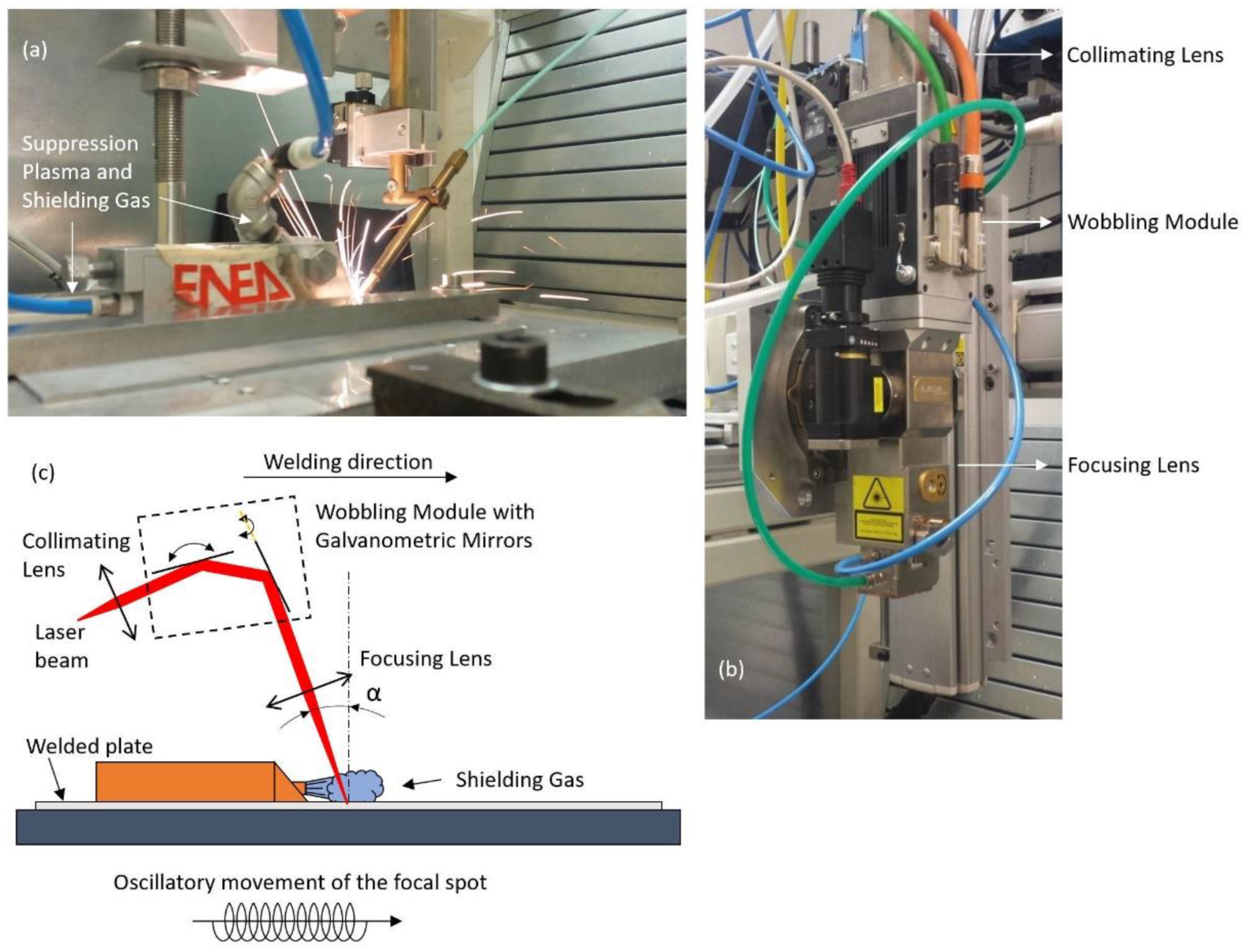
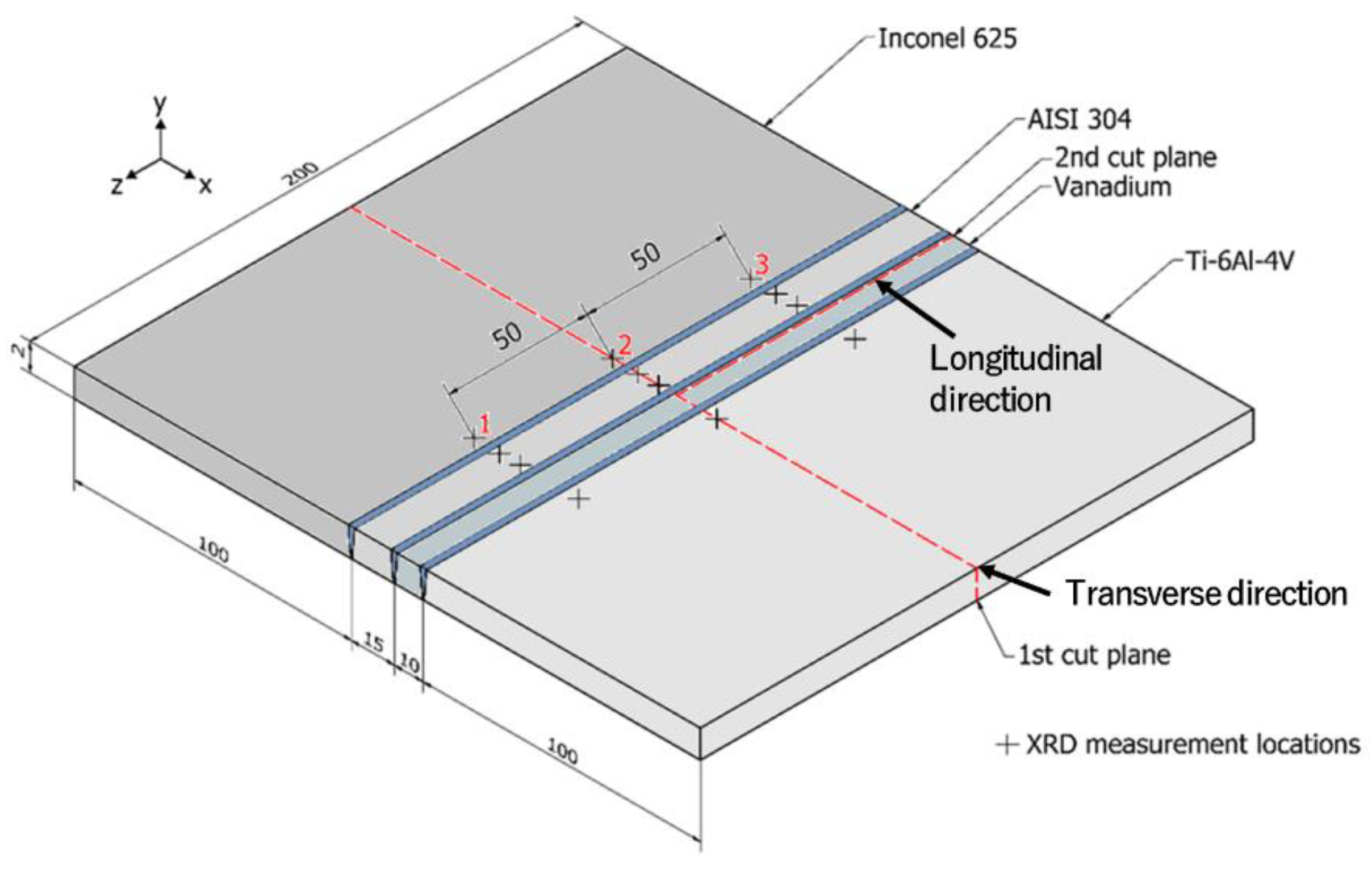

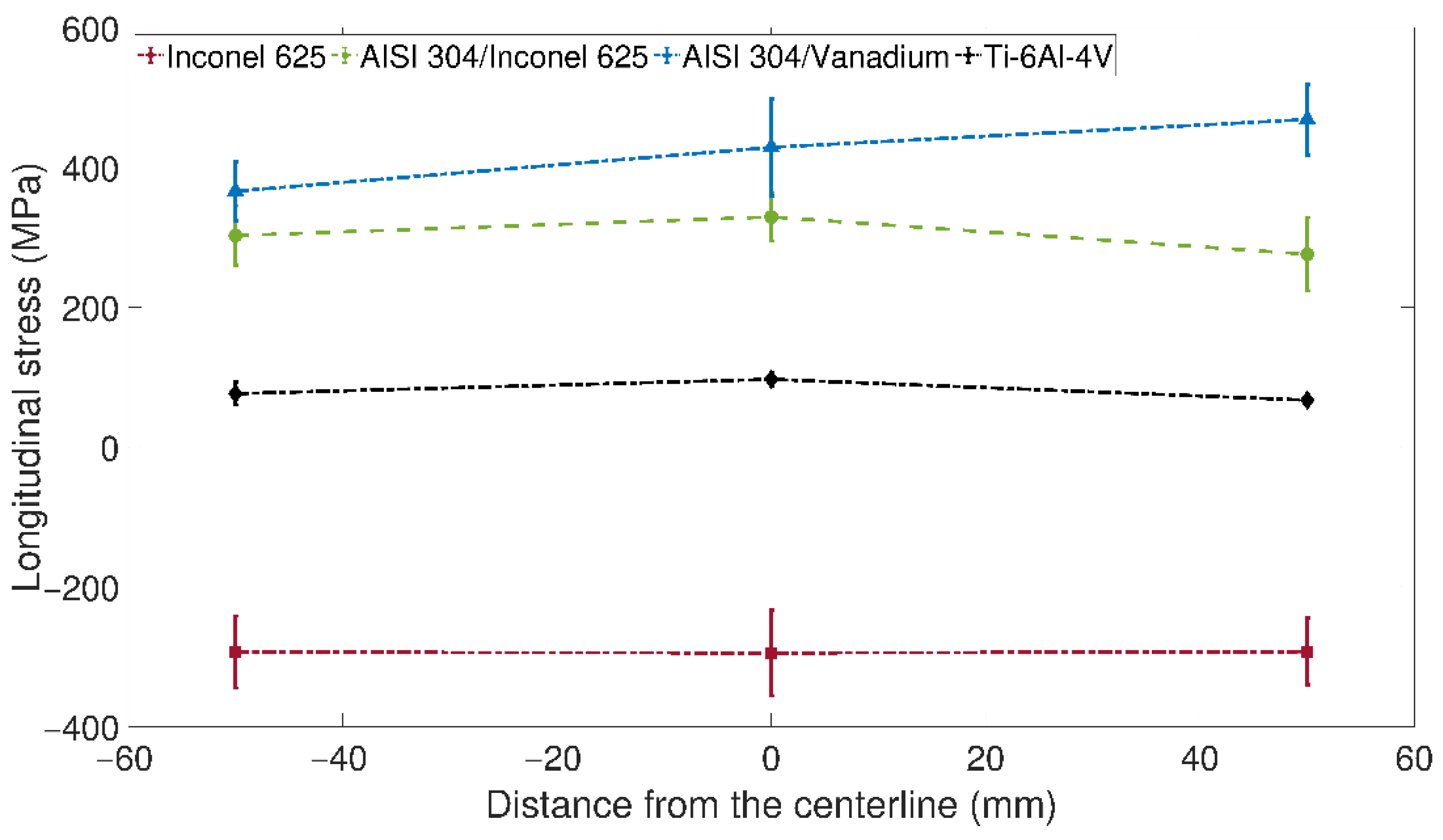
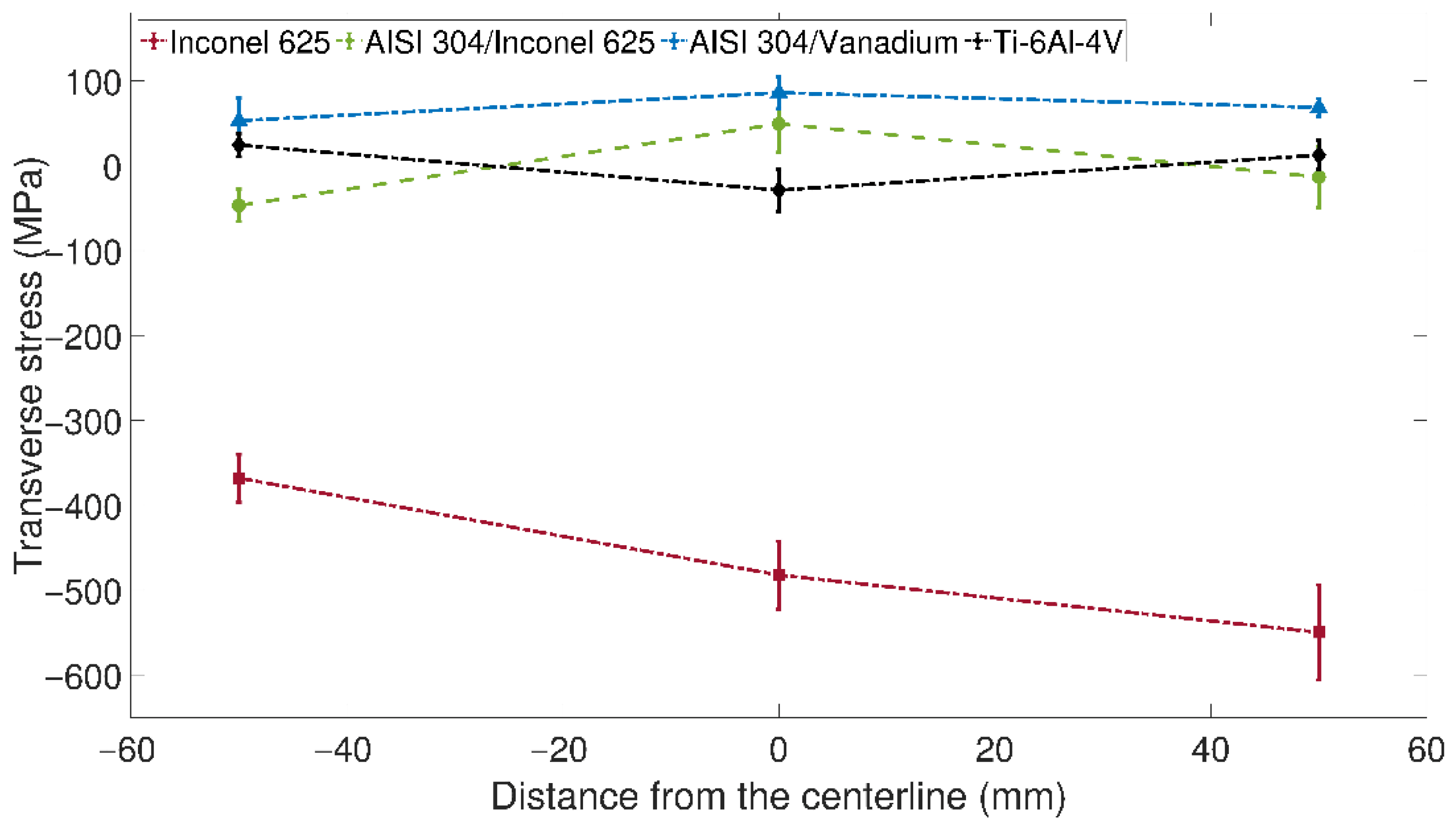
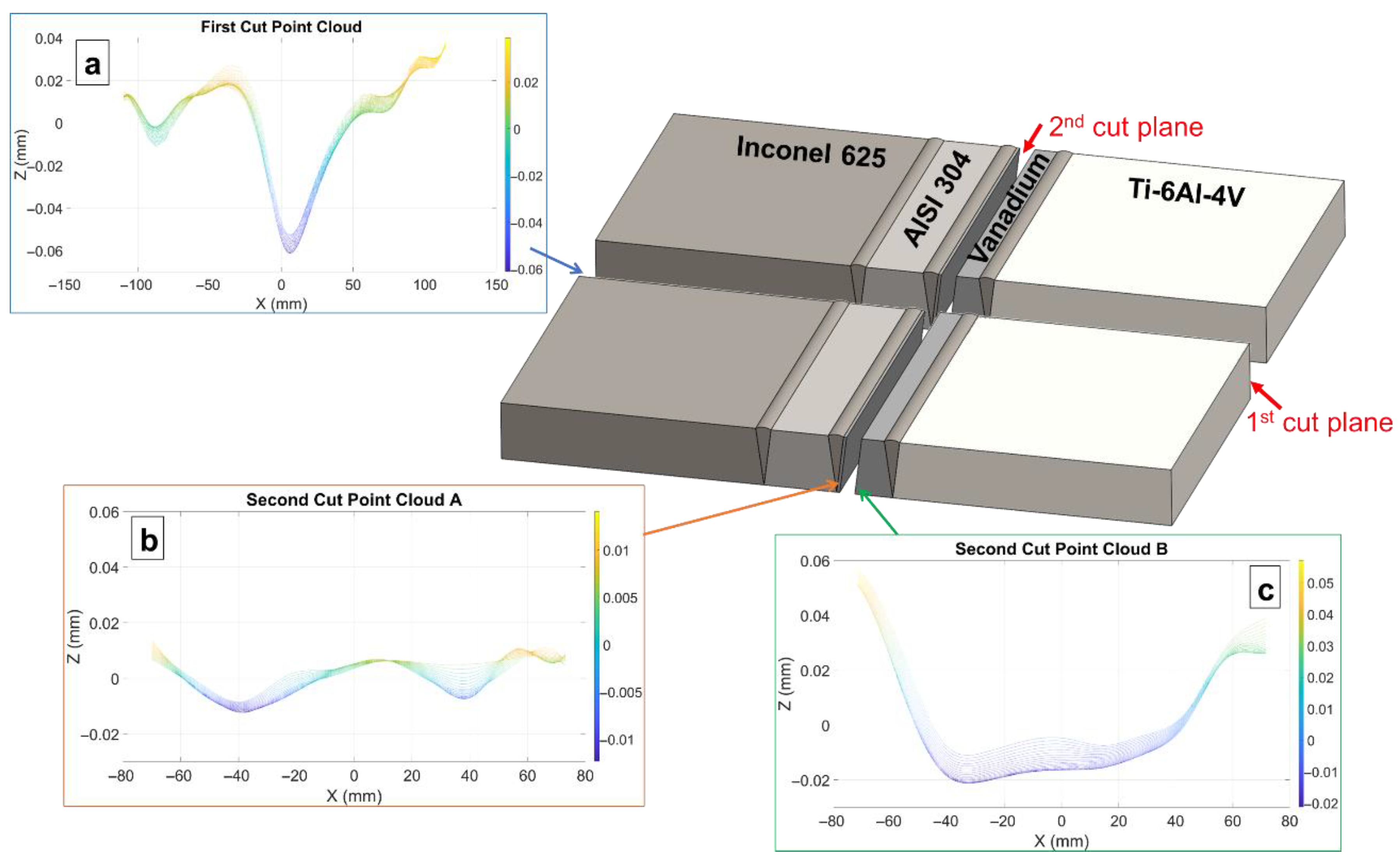
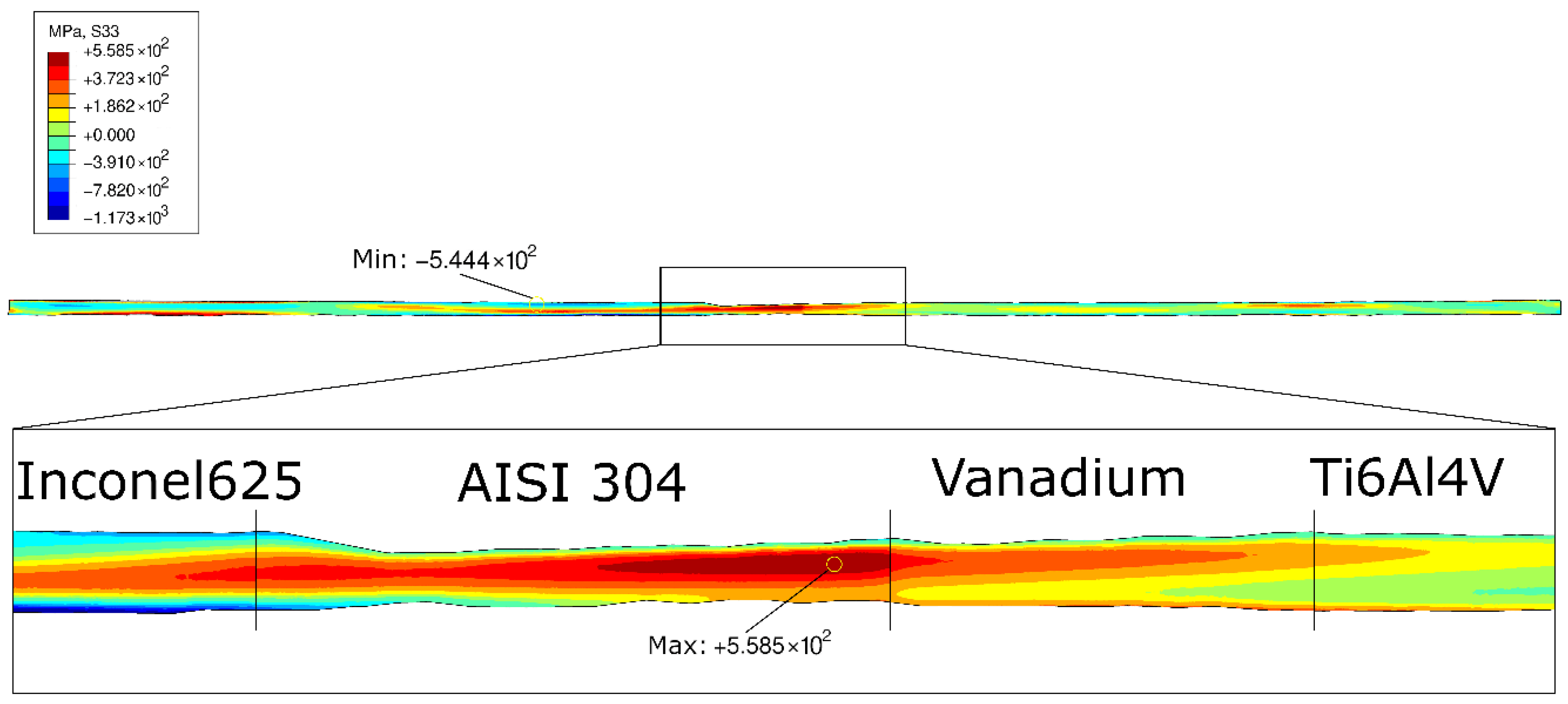





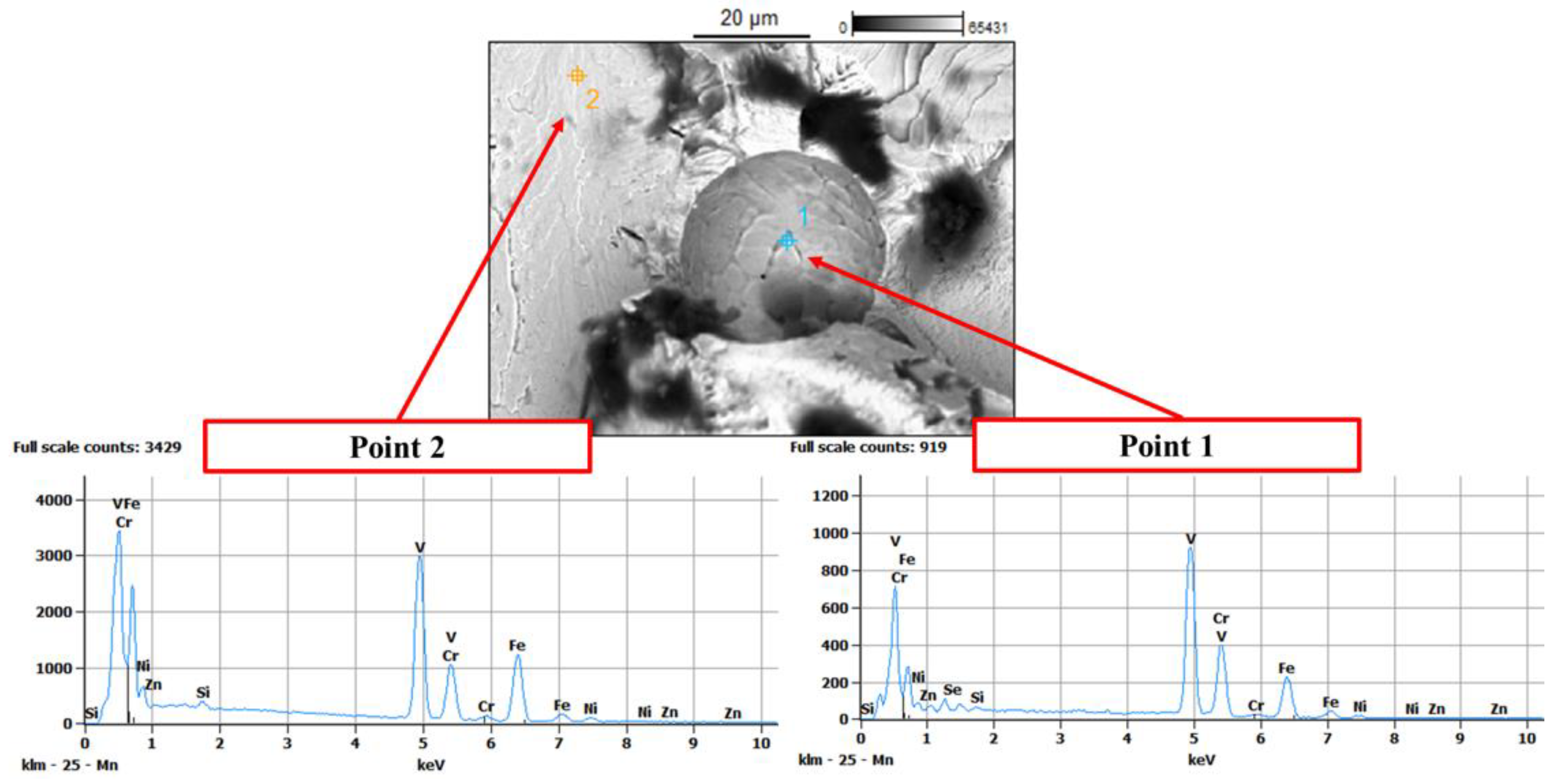

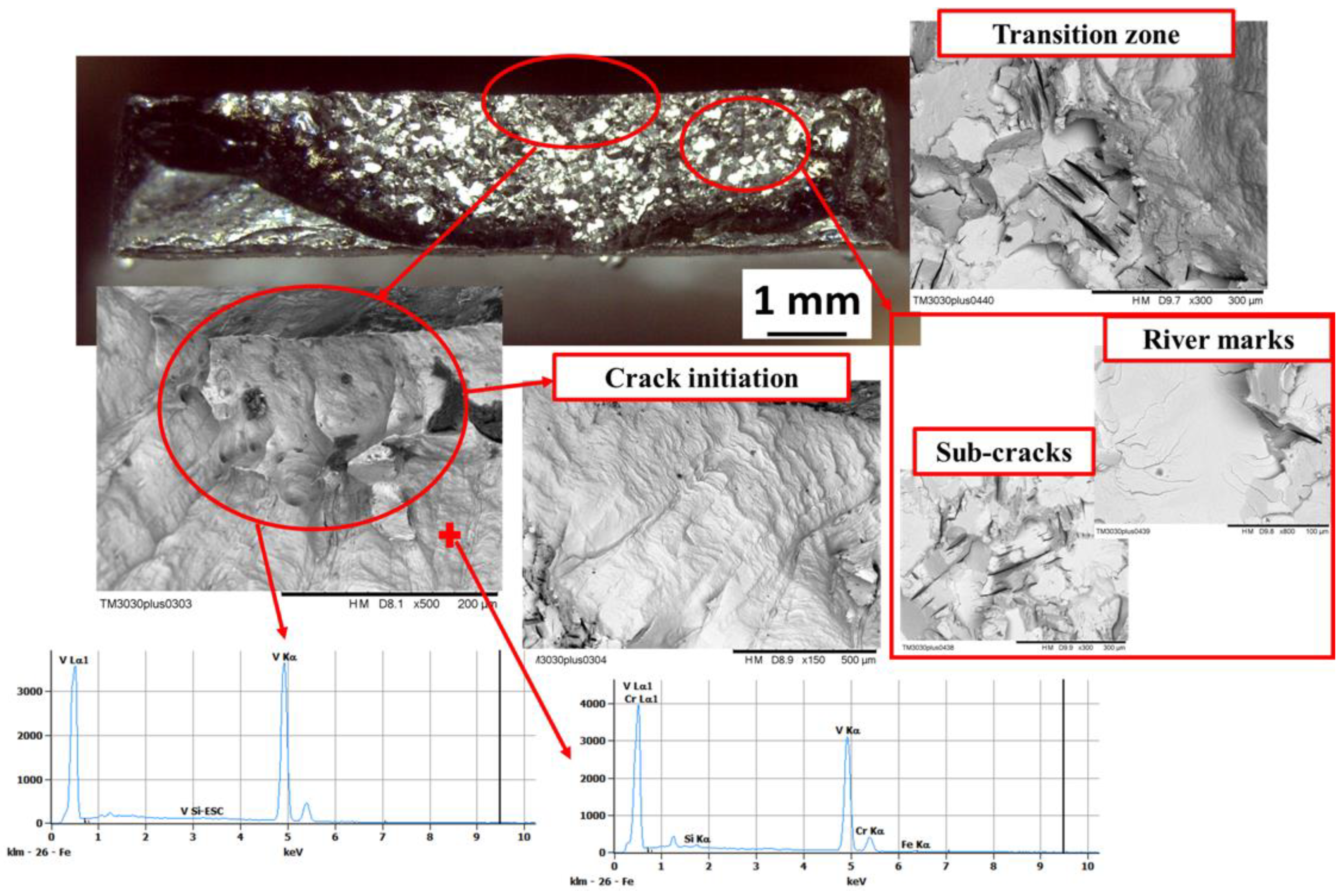
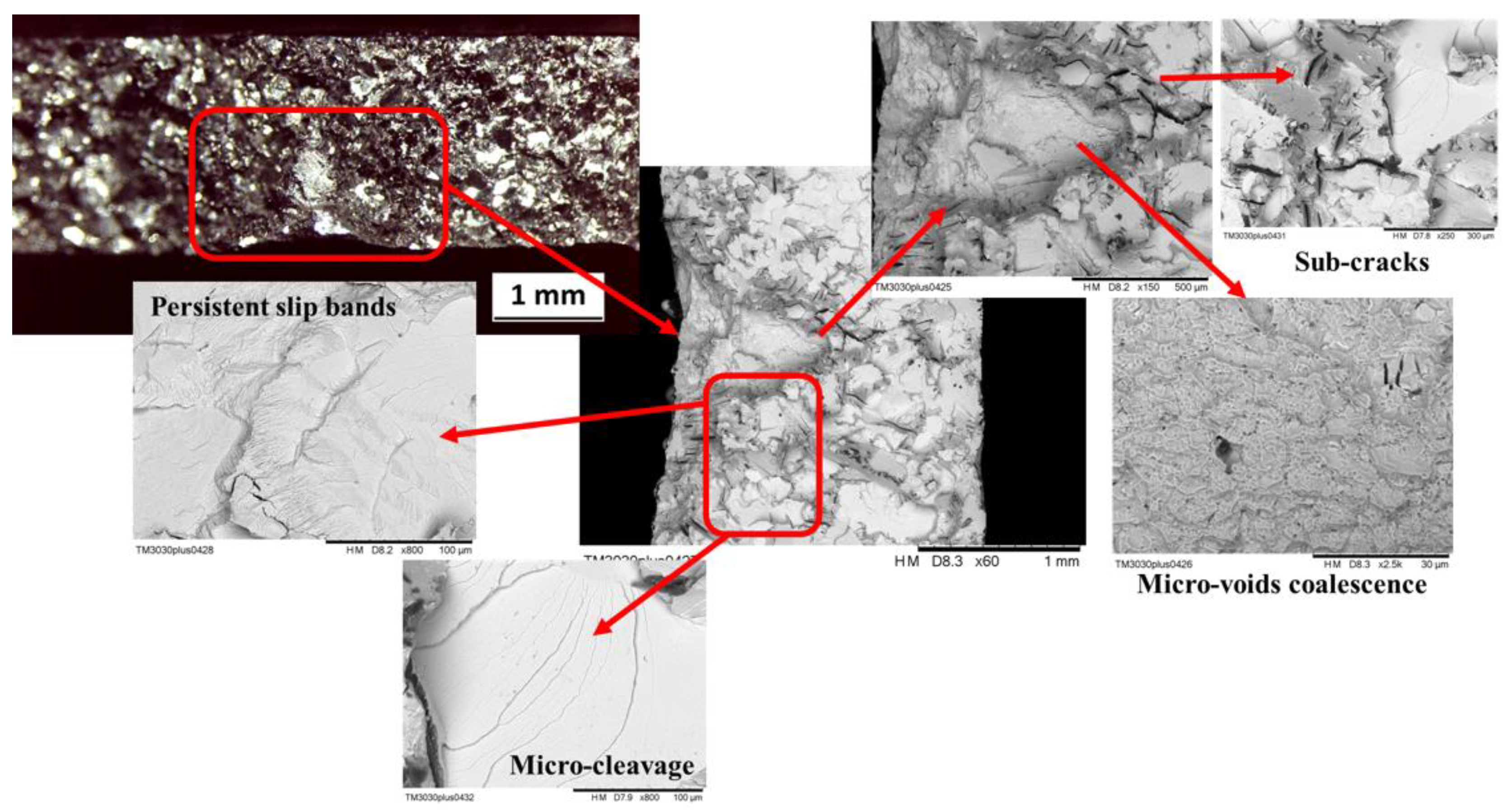
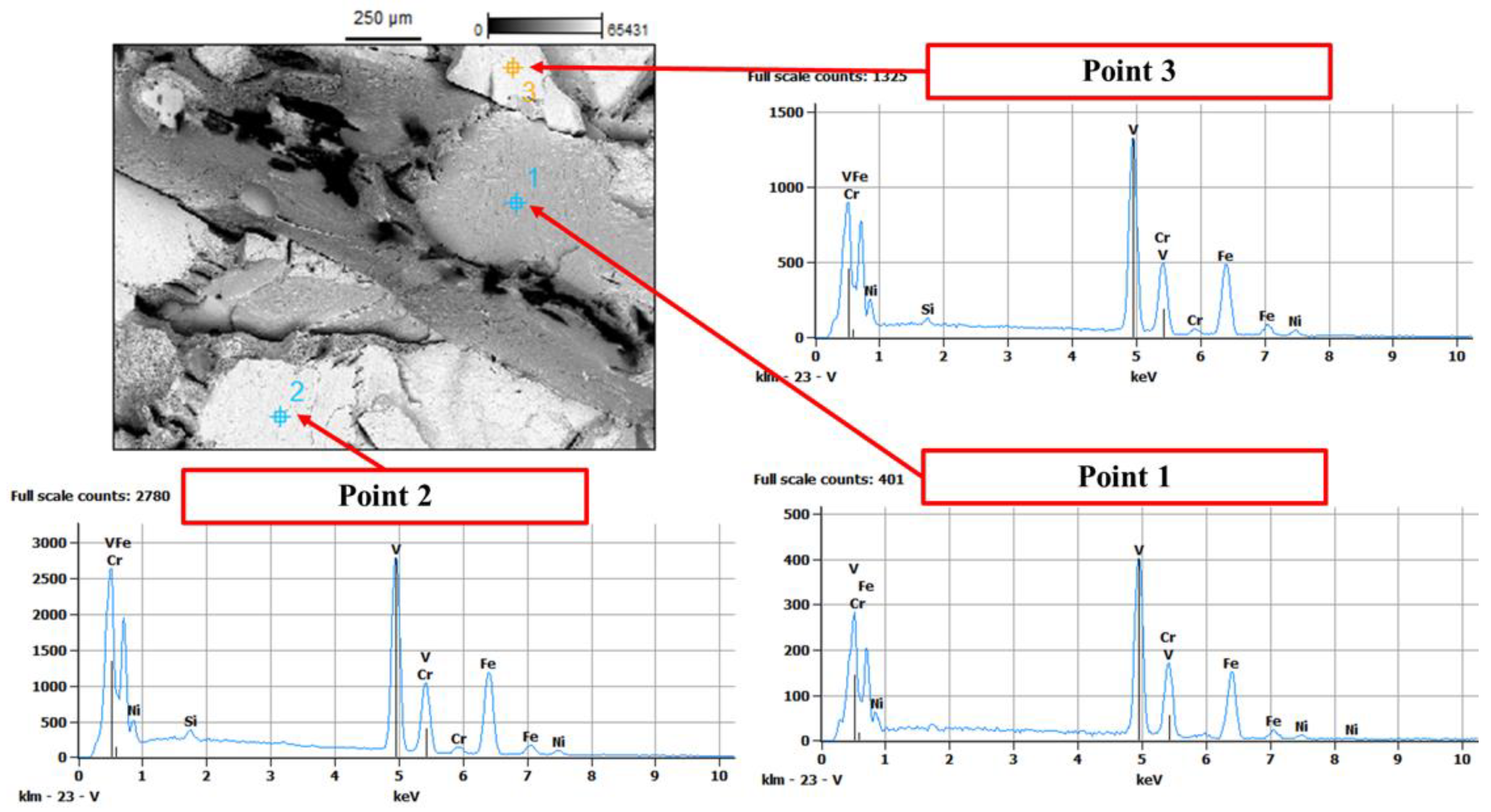
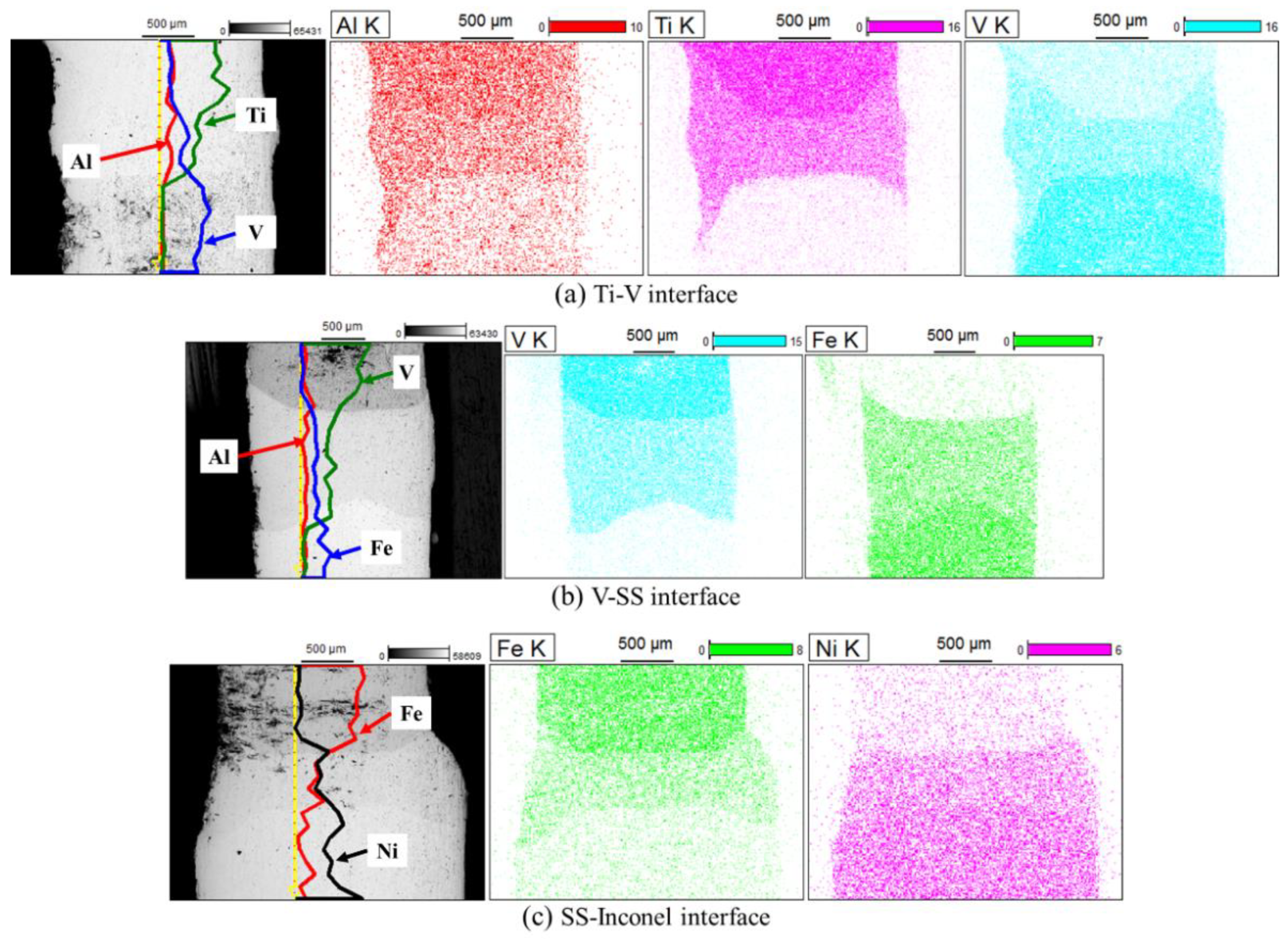
| Elements | Ti6Al4V | Vanadium | AISI 304 | Inconel 625 |
|---|---|---|---|---|
| Al | 5.5–6.8 | - | - | ≤0.40 |
| C | - | - | - | ≤0.10 |
| Co | - | - | - | ≤1.0 |
| Cr | - | - | 19.96 ± 0.27% | 20.0–23.0 |
| Cu | - | - | 0.7 ± 2.79% | - |
| Fe | ≤0.30 | - | 71.13 ± 0.18% | ≤5.0 |
| H | ≤0.015 | - | - | - |
| Mo | - | - | 0.27 ± 2.36% | 8.0–10.0 |
| Mn | - | - | - | ≤ 0.50 |
| N | ≤0.05 | - | - | - |
| Nb | - | - | - | 3.15–4.15 |
| Ni | - | - | 7.82 ± 0.66% | ≥58.0 |
| O | ≤0.20 | - | - | - |
| Si | - | - | - | ≤0.50 |
| Ti | Balance | - | 0.12 ± 2.05% | ≤0.40 |
| V | 3.5–4.5 | ≥99.9 | - | - |
| Materials | σy [MPa] | σu [MPa] | E [GPa] | v | ɛu % |
|---|---|---|---|---|---|
| Ti6Al4V | 880 | 950 | 125.5 | 0.36 | 10 |
| Vanadium | 439 | 472 | 120.2 | 0.36 | 27 |
| AISI 304 | 215 | 515 | 196 | 0.28 | 70 |
| Inconel 625 | 460 | 880 | 208 | 0.28 | 45 |
| Material | Tube | Exposure Time (s) | No. of Tilts | Tilt Angle (°) | Psi Oscillation | Collimator Diameter (mm) | Voltage (kV) | Current (mA) |
|---|---|---|---|---|---|---|---|---|
| Inconel 625 | Cr | 35 | 4 | ±45 | ±3 | 1 | 30 | 8.0 |
| AISI 304 | Cr | 60 | 4 | ±45 | ±0 | 1 | 30 | 8.0 |
| Ti6Al4V | Ti | 40 | 4 | ±40 | ±0 | 1 | 30 | 7.5 |
| Cuts | Knot Spacing [mm] | Average Stress Uncertainty [MPa] |
|---|---|---|
| First Cut | 18.72 | 32.05 |
| Second Cut Side A | 15.82 | 78.10 |
| Second Cut Side B | 14.32 | 12.22 |
| Second Cut Average | - | 35.92 |
| Property | Inconel 625 | AISI 304 | Vanadium | Ti6Al4V |
|---|---|---|---|---|
| CTE [µm/m K−1] | 12.8 | 17.3 | 8.3 | 9.0 |
| Specimen | Δσ [MPa] | Number of Cycles to Failure | Zone of Fracture |
|---|---|---|---|
| 1 | 140 | 5,000,000 | Runout |
| 2 | 160 | 5,000,000 | Runout |
| 3 | 170 | 1,148,109 | V-SS |
| 4 | 180 | 1,011,176 | Ti-V |
| 5 | 180 | 2,885,345 | Ti-V |
| 6 | 200 | 440,740 | Ti-V |
| 7 | 200 | 192,951 | V-SS |
| 8 | 220 | 67,000 | Ti-V |
| 9 | 220 | 149,345 | V-SS |
| Specimen | Δσ [MPa] | Nfracture | Fracture Zone | Sq [μm] | Ssk | Sku | Sp [μm] | Sv [μm] | Sz [μm] | Sa [μm] |
|---|---|---|---|---|---|---|---|---|---|---|
| 6 | 200 | 440,740 | Ti-V | 48.54 | 0.11 | 2.45 | 127.63 | 102.33 | 229.97 | 39.72 |
| 7 | 200 | 192,951 | V-SS | 49.80 | −0.15 | 1.98 | 101.60 | 136.25 | 237.85 | 42.87 |
| Specimen | Δσ [MPa] | Nfracture | Fracture Zone | Fracture Mode |
|---|---|---|---|---|
| 8 | 220 | 67,000 | Ti-V | ductile (striations) |
| 9 | 220 | 149,345 | V-SS | brittle (micro-cleavage) |
| Specimen | Δσ [MPa] | Nfracture | Fracture Zone | Fracture Mode |
|---|---|---|---|---|
| 1 | 140 | 5,000,000 | runout | - |
| 2 | 160 | 5,000,000 | runout | - |
| 3 | 170 | 1,148,109 | V-SS | mixed (PSB, micro-voids coalescence, micro-cleavage) |
| 4 | 180 | 1,011,176 | Ti-V | ductile (striations) |
| 5 | 180 | 2,885,345 | Ti-V | ductile (striations) |
| 6 | 200 | 440,740 | Ti-V | brittle and flat (affected by voids, does not change fracture interface but fracture mode and fatigue life) |
| 7 | 200 | 192,951 | V-SS | brittle (micro-cleavage) |
| 8 | 220 | 67,000 | Ti-V | ductile (striations) |
| 9 | 220 | 149,345 | V-SS | brittle (micro-cleavage) |
Publisher’s Note: MDPI stays neutral with regard to jurisdictional claims in published maps and institutional affiliations. |
© 2022 by the authors. Licensee MDPI, Basel, Switzerland. This article is an open access article distributed under the terms and conditions of the Creative Commons Attribution (CC BY) license (https://creativecommons.org/licenses/by/4.0/).
Share and Cite
Carone, S.; Corigliano, P.; Epasto, G.; Moramarco, V.; Palomba, G.; Pappalettera, G.; Casavola, C. Innovative Approach for the Evaluation of the Mechanical Behavior of Dissimilar Welded Joints. Metals 2022, 12, 2039. https://doi.org/10.3390/met12122039
Carone S, Corigliano P, Epasto G, Moramarco V, Palomba G, Pappalettera G, Casavola C. Innovative Approach for the Evaluation of the Mechanical Behavior of Dissimilar Welded Joints. Metals. 2022; 12(12):2039. https://doi.org/10.3390/met12122039
Chicago/Turabian StyleCarone, Simone, Pasqualino Corigliano, Gabriella Epasto, Vincenzo Moramarco, Giulia Palomba, Giovanni Pappalettera, and Caterina Casavola. 2022. "Innovative Approach for the Evaluation of the Mechanical Behavior of Dissimilar Welded Joints" Metals 12, no. 12: 2039. https://doi.org/10.3390/met12122039
APA StyleCarone, S., Corigliano, P., Epasto, G., Moramarco, V., Palomba, G., Pappalettera, G., & Casavola, C. (2022). Innovative Approach for the Evaluation of the Mechanical Behavior of Dissimilar Welded Joints. Metals, 12(12), 2039. https://doi.org/10.3390/met12122039










